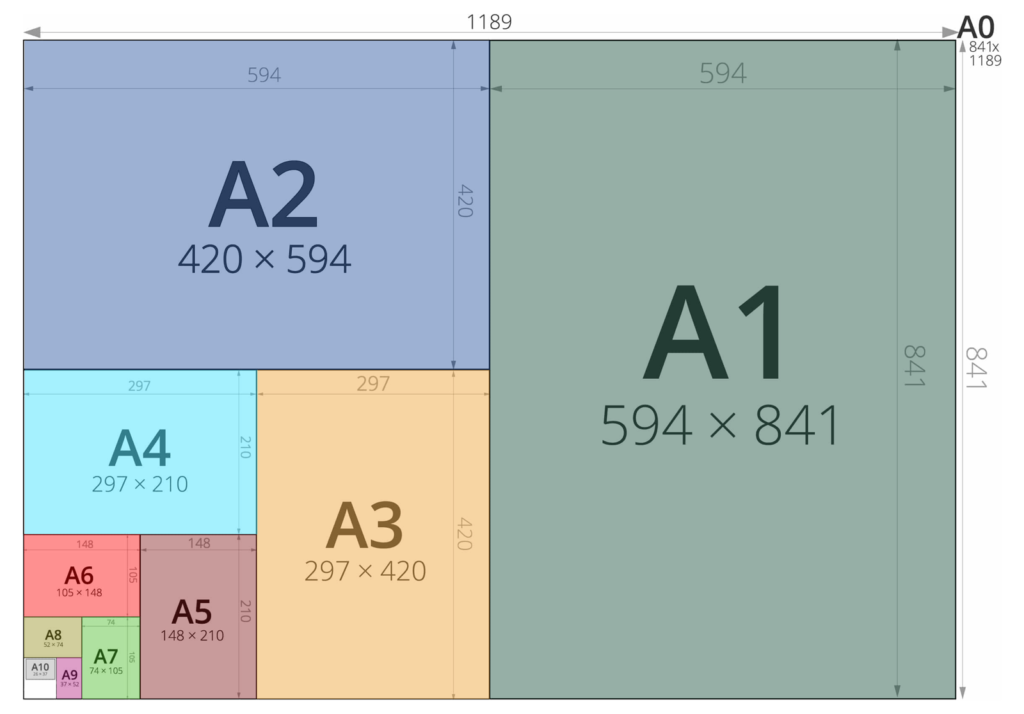Guide for
Printing Materials
Step 2 - Define your Print Size
Choosing your final product size can be tricky. As the paper sizes grow, as do their weight and the ability to handle or get them delivered may be compromised.
It’s important to understand that each print size is meant for specific purposes. A catalogue, for example, should not be printed on an A3 paper size. This size would just be extremely difficult for the reader to flip pages, manage, store and read all letters.
When talking about printing, you can choose pretty much any size you’d like, even a custom format. Although, it is advisable that, whenever possible, you stick with international standard paper sizes. Since these sizes are how stock paper is produced, you will use the full paper sheet, and more importantly, keeping your cost down with printing as it enables us to utilise the maximum print area.
Whenever printing custom sized materials, it is very likely that the printing shop will have to trim the paper to match your custom size. The trimmed part usually can’t be reused, and therefore will be disposed.
For example, if one decides for a custom size of 420x500mm. The print shop would have to print your material on an A2 sized paper (which is the stock size closer to your custom size) and charge you for the full A2 size. There will be a waste of 420x94mm per sheet.
Needless to say wasting paper is bad for the planet, right?
Standard Paper Sizes
As we mentioned, paper stock is produced utilising International Standard Paper Sizes. The standard exists to minimise paper waste and speed-up the paper production process.
You can find below the most common international standard paper sizes. As a thumb rule, each size is exactly half of its immediate larger size. For example, an A4 size is exactly half of the A3 paper size.
Paper Sizes start at A0, being the largest one, and go all the way down to A10, being the smaller size available.
Choosing the right Print Sizes
Large Sizes
Large sized printed products are intended to capture the attention of your audience. Due to it’s size and weight, it may be difficult to handle or deliver.
These sizes are great to be fixed in shop windows or walls, remember to choose a location wisely, look for a place with heavy foot-traffic or places where people are most likely to look.
Eg: behind the cashier’s table on a shop.
Large sizes are usually A3, A2, A1, A0 or larger.
Pros
- Better visibility
- Extra space to display your images
- Extra space for compelling words / promotional
Cons
- Harder to handle or distribute
- Needs to be fixed somehow
- Can be more expensive
Medium Sizes
Medium sized printed products are useful for many situations, from printing documents to hand-outs as promotional flyers.
For being smaller, they should be light-weight enough to enable better handling, stacking and delivering. Being hand-delivered to your audience is a must, as they will not be able to read the content from a distance and are likely to need some time to read the content of your material.
Medium Sizes are usually A4, A5 and DL (110mm x 210mm).
Pros
- Enough space for your product description
- Enough space to display a good product image
- Ideal size to present products
Cons
- Readers may need time to read it thoroughly
- Can be discarded by the recipient upon receipt
- Needs to be hand-delivered to your audience
Small Sizes
The smaller sizes are a great cost-effective option.
For being smaller, mass production is often cheaper, allowing you to deliver your message to more people.
Promotional cards are an example of small print size that can make a huge impact to your audience.
Small sizes are usually from A6 to A10.
Pros
- Easy to hand-out
- Great for promotions and deals
- Recipient usually reads it right away or put away for later
Cons
- Not much space for descriptions
- Message should be short and compeling
- Requires a more creative design to retain attention
Already defined the print size?
Let's move on
Subscribe to our Newsletter
Stay updated with our news and receive exclusive offers!
Designed by F2F Digital in association with Quantum Print
